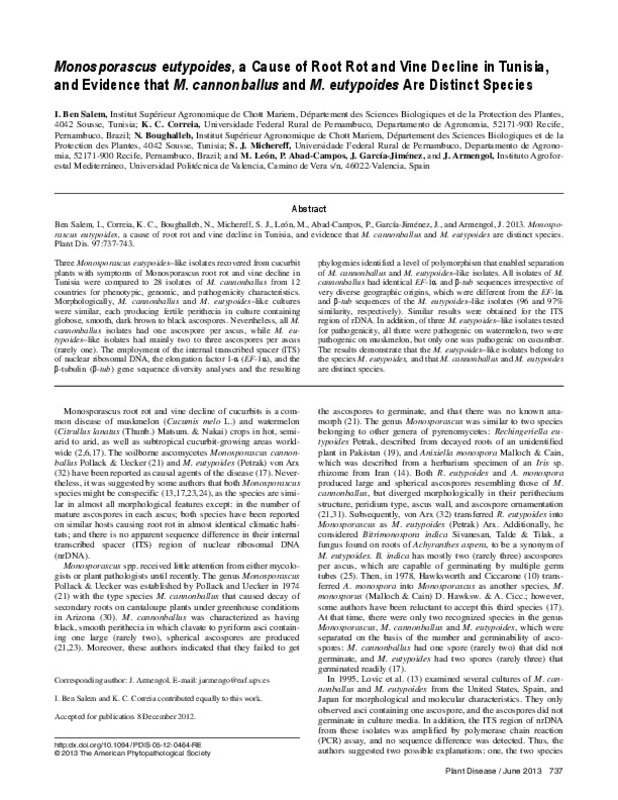JavaScript is disabled for your browser. Some features of this site may not work without it.
Buscar en RiuNet
Listar
Mi cuenta
Estadísticas
Ayuda RiuNet
Admin. UPV
Monosporascus eutypoides, a cause of root rot and vine decline in Tunisia, and evidence that M. cannonballus and M. eutypoides are distinct species
Mostrar el registro sencillo del ítem
Ficheros en el ítem
| dc.contributor.author | Ben Salem, I.
|
es_ES |
| dc.contributor.author | Correia, K. C.
|
es_ES |
| dc.contributor.author | Boughalleb, N.
|
es_ES |
| dc.contributor.author | Michereff, Sami Jorge
|
es_ES |
| dc.contributor.author | León Santana, Maela
|
es_ES |
| dc.contributor.author | Abad Campos, Paloma
|
es_ES |
| dc.contributor.author | García Jiménez, José
|
es_ES |
| dc.contributor.author | Armengol Fortí, Josep
|
es_ES |
| dc.date.accessioned | 2016-07-07T13:20:24Z | |
| dc.date.available | 2016-07-07T13:20:24Z | |
| dc.date.issued | 2013-06 | |
| dc.identifier.issn | 0191-2917 | |
| dc.identifier.uri | http://hdl.handle.net/10251/67329 | |
| dc.description.abstract | [EN] Three Monosporascus eutypoides–like isolates recovered from cucurbit plants with symptoms of Monosporascus root rot and vine decline in Tunisia were compared to 28 isolates of M. cannonballus from 12 countries for phenotypic, genomic, and pathogenicity characteristics. Morphologically, M. cannonballus and M. eutypoides–like cultures were similar, each producing fertile perithecia in culture containing globose, smooth, dark brown to black ascospores. Nevertheless, all M. cannonballus isolates had one ascospore per ascus, while M. eutypoides–like isolates had mainly two to three ascospores per ascus (rarely one). The employment of the internal transcribed spacer (ITS) of nuclear ribosomal DNA, the elongation factor 1-α (EF-1α), and the β-tubulin (β-tub) gene sequence diversity analyses and the resulting phylogenies identified a level of polymorphism that enabled separation of M. cannonballus and M. eutypoides–like isolates. All isolates of M. cannonballus had identical EF-1α and β-tub sequences irrespective of very diverse geographic origins, which were different from the EF-1α and β-tub sequences of the M. eutypoides–like isolates (96 and 97% similarity, respectively). Similar results were obtained for the ITS region of rDNA. In addition, of three M. eutypoides–like isolates tested for pathogenicity, all three were pathogenic on watermelon, two were pathogenic on muskmelon, but only one was pathogenic on cucumber. The results demonstrate that the M. eutypoides–like isolates belong to the species M. eutypoides, and that M. cannonballus and M. eutypoides are distinct species. | es_ES |
| dc.description.sponsorship | We thank Z. Banihashemi (College of Agriculture, Shiraz University, Shiraz, Iran), B. D. Bruton (USDA, Lane, OK, USA), A. Infantino (Istituto Sperimentale per la Patologia Vegetale, Rome, Italy), G. Quilosi (Facolta di Agraria, Universita degli Studi della Tuscia, Viterbo, Italy), and A. Sarpeleh (Plant Protection Research Institute, Tehran, Iran) for providing strains of Monosporascus, without which this study would not have been possible. This research was supported financially by the Projects A/3878/05, A/5352/06, and A/017593/08 (Programa de Cooperacion Cientifica e Investigacion Inter-Universitaria entre Espana y Tunez, PCI-Mediterraneo, Ministerio de Asuntos Exteriores y Cooperacion), and by CAPES (Project 203/2009 - International Cooperation CAPES-Brazil/DGU-Spain). We are thankful to CAPES (Brazil) for the research fellowships granted to K. C. Correia and S. J. Michereff. | |
| dc.language | Inglés | es_ES |
| dc.publisher | American Phytopathological Society | es_ES |
| dc.relation.ispartof | Plant Disease | es_ES |
| dc.rights | Reserva de todos los derechos | es_ES |
| dc.subject | Sequence-analysis | es_ES |
| dc.subject | Cantaloupe roots | es_ES |
| dc.subject | IMI descriptions | es_ES |
| dc.subject | Fungi | es_ES |
| dc.subject | RDNA | es_ES |
| dc.subject | Ascomycete | es_ES |
| dc.subject | Watermelon | es_ES |
| dc.subject | Ascopores | es_ES |
| dc.subject | Position | es_ES |
| dc.subject | Disease | es_ES |
| dc.subject.classification | PRODUCCION VEGETAL | es_ES |
| dc.title | Monosporascus eutypoides, a cause of root rot and vine decline in Tunisia, and evidence that M. cannonballus and M. eutypoides are distinct species | es_ES |
| dc.type | Artículo | es_ES |
| dc.identifier.doi | 10.1094/ PDIS-05-12-0464-RE | |
| dc.relation.projectID | info:eu-repo/grantAgreement/MAEC//A%2F3878%2F05/ES/CARACTERIZACIÓN DE HONGOS DEL SUELO PATÓGENOS DEL CULTIVO DE SANDÍA EN TÚNEZ %2F CARACTÉRISATION DES CHAMPIGNONS TELLURIQUES PATHOGENES DE LA CULTURE DE PASTÈQUE EN TUNISIE/ | es_ES |
| dc.relation.projectID | info:eu-repo/grantAgreement/CAPES//203%2F2009/ | es_ES |
| dc.relation.projectID | info:eu-repo/grantAgreement/MAEC//A%2F5352%2F06/ES/ CARATERIZACIÓN DE MONOSPORASCUS CANNONBALLUS PATÓGENO DEL CULTIVO DE SANDÍA EN TÚNEZ/ | es_ES |
| dc.relation.projectID | info:eu-repo/grantAgreement/MAEC//A%2F017593%2F08/ES/Estudio fenotípico de aislados tunecinos y españoles de Monosporascus cannonballus y evaluación de fungicidas in vitro/ | |
| dc.rights.accessRights | Abierto | es_ES |
| dc.contributor.affiliation | Universitat Politècnica de València. Instituto Agroforestal Mediterráneo - Institut Agroforestal Mediterrani | es_ES |
| dc.contributor.affiliation | Universitat Politècnica de València. Departamento de Ecosistemas Agroforestales - Departament d'Ecosistemes Agroforestals | es_ES |
| dc.description.bibliographicCitation | Ben Salem, I.; Correia, KC.; Boughalleb, N.; Michereff, SJ.; León Santana, M.; Abad Campos, P.; García Jiménez, J.... (2013). Monosporascus eutypoides, a cause of root rot and vine decline in Tunisia, and evidence that M. cannonballus and M. eutypoides are distinct species. Plant Disease. 97(6):737-743. https://doi.org/10.1094/ PDIS-05-12-0464-RE | es_ES |
| dc.description.accrualMethod | S | es_ES |
| dc.relation.publisherversion | https://dx.doi.org/10.1094/PDIS-05-12-0464-RE | es_ES |
| dc.description.upvformatpinicio | 737 | es_ES |
| dc.description.upvformatpfin | 743 | es_ES |
| dc.type.version | info:eu-repo/semantics/publishedVersion | es_ES |
| dc.description.volume | 97 | es_ES |
| dc.description.issue | 6 | es_ES |
| dc.relation.senia | 245598 | es_ES |
| dc.contributor.funder | Ministerio de Asuntos Exteriores y Cooperación | |
| dc.contributor.funder | Coordenaçao de Aperfeiçoamento de Pessoal de Nível Superior, Brasil |








